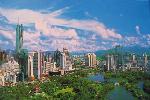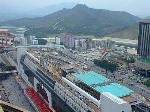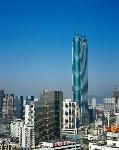- Getting around Lijiang. Dont stay in the Old Towns more than 2 days, there is nothing to do. KRISS Oct 9, 2013 05:46
- 2013 Beijing Temple Fair BENNYLAU Feb 26, 2013 03:29
- Malaysian traveling from KUL - LAX vis Shanghai PVG ZATI_DY Jan 3, 2013 20:15
Really Shenzhen
- Views: 4645
- |Vote: 0 0
- |Add to Favorites
- |Recommend to Friends
The Imitation, or the Real Thing
Shenzhen is a city that is difficult to place for a traveller, somewhere on the China destinations list that falls outside of the general categories. China's traditional old cities are home to those aging temples and curvaceously styled stone and timber homes that we who tread the China trail have come to know and love; Her poorer towns bustle and decay in the ancient air; the modern metropolises are complicated affairs where international excitements and poisons sit side by side, and where the march of history has created convoluted riddles of political ethics. But in Shenzhen there's none of that - just a thriving commercial city built on an empty plot some 25 years ago when it was nothing more than a fishing village and a train station on the border of Hong Kong called Baoan.
Foreigners visiting the city love to hate it. They call it the ultimate city in a bubble, the metropolitan empty shell, the capital of imitation. A conundrum of pretty high-rises and superbly landscaped parklands and side streets. They claim the city has no culture or integrity, that it's all just one big, plastic package geared towards one simple goal - the accumulation of money. On the other hand, those foreigners that do tend to sing its praises often quote the city's shallower drawcards - modern nightlife, the number of groovy bars and the scores of psirens at the local nightclubs.
Whilst no Chinese destination could ever be so black and white, some of these complaints and lewd recommendations are fairly accurate. The city was designated a special economic zone back in 1980 in a rush to cash in on increasing trade with Hong Kong and the outside world in tune with the opening economic policies of the day. Although at the time China's economy was far more strictly protected than it is today, zones like Shenzhen were to be given the benefit of far more liberal economic policies so as to stimulate the rest of the country's economy - and the success of these policies can be seen clearly in Shenzhen today.
Soon after the announcement, capital poured into the city, highways were dug and tower after tower cropped up on the previously empty plots. Within a decade, Shenzhen had an international face to rival that of mega-city Hong Kong just across the border, something that had taken the later a hundred years to build up. Foreigners are now everywhere to be seen in the city, both on business and living decadent expat lifestyles in the aura of new and fresh opportunity. Wealthy Chinese have chosen the place as a new haven, buying new, luxurious homes and rubbing shoulders with each other in brand, spanking new office spaces. Shenzhen is the new land of opportunity, and whether you're of the opinion that it's for the better or worse, Shenzhen is a city that will leave an impression on you for its youthful atmosphere and a vibrant culture still in its infancy. Shenzhen's beauty - whether you regard it as imitation or not - is manifest and on proud display.
On Business
Given the city's reputation, I may never have found the time to make my way right down to the bottom south-eastern corner of China to visit the town had I not too been sent there on business. I tend to go for places with a little history and culture if I can, and I'd heard enough to be almost convinced that there was none of it to be found in the place.
I was taken by car along the highway from neighbouring Guangdong - the journey takes little more than an hour if that - and I was despairing of the heat. That far down, China is tropical and sweaty in climate, and I hadn't been in a hot region quite like it since last visiting Malaysia some years beforehand, and wasn't yet used to wandering around in the beating sun wearing a suit and tie. Yet I have to admit that despite my initial reservations, I was quite taken with Shenzhen as we approached. I'd been told it was practically a plastic paradise, replete with tacky quick-fire architecture and foliage arranged in unnaturally perfect rows. On the face of it, it didn't seem anything of the sort - as a fresh, new city, I found the design of the general town layout to seem ordered and consistent. Shenzhen is indeed some kind of paradise - in the bright sunshine, the architecture sparkles and the surroundings are well forested, lush and organic. From this perspective, Shenzhen seemed positively engaging, and I found myself looking forward to the opportunity to get to see some of its real character.
I was to be treated to first class accommodation, paid for by the firm - the Shenzhen Shangri-la hotel, situated not far away from the central railway station. As we pulled up to the hotel, I noticed that the streets were packed - not with affluent businessmen formerly of Hong Kong, as I'd anticipated, but with quite the opposite - lower income earners, perhaps migrant workers - and without doubt predominantly country folk come to this new jewel of a city to make their desperate dash at fortune. All across the main streets from the station and almost to the front steps of the hotel, people stood waving and calling pedestrians to booths or street-side stalls, hoping to make sales and earn a few extra yuan for the day's takings. Even as I carried my bags to the door - the porter had been eager to take them for me, but I felt embarrassed by the attention - I was hailed by vendors on the street. Clearly, the allure of seemingly affluent hotel guests was a strong draw for those seeking to climb their way up Shenzhen's money ladder.
Shangri-la is luxury accommodation anywhere in the world - Shenzhen is no exception. My room had an exceptional view of the district - which from my angle seemed to be far more of an elaborate and wonderful mess than I'd been led to expect of Shenzhen - and I noted with particular interest the view of the grasslands just out to the city's exterior border. A tall fence divides the territory of Hong Kong just a short walk away from the hotel, and on the other side, the developments abruptly fall off to nothing. Plain, grassy hills, just as have always been there. Walk farther south - if it were allowed - and you'll be amongst the wealth and glamour of Hong Kong proper. As far as I could see, there didn't seem to be much that Shenzhen was lacking to make the trip worthwhile.
Wandering Shenzhen
Business matters dealt with, I had the chance to wander the side streets a little and see what was at the essence of Shenzhen life. My initial impressions turned out to be correct - there are so many street vendors around the suburb that one might be forgiven for thinking that Shenzhen is indeed a large shopping mall. Everything is on sale, mostly the kinds of gadgets that you normally expect to see in border towns - watches and wallets, as well as rows and rows of mobile phone stores. The price tags were average, but from overhearing the intense bargaining that was going on, it seemed that this was certainly the place to come to collect absolute bargains.
I also noticed the food - Guangdong has the most multifarious cuisine in the country, and although Shenzhen isn't your average Guangdong town, it's still part of the province and the culinary delights on offer are just as numerous as anywhere else in the region. Down at street level, the city doesn't seem so squeaky clean as it does up on the business deck in the office towers. Hundreds of little cheap dives offer authentic food from around the country, and there are always people eating, just as Cantonese people are born to do. Not that everyone here is local, however - given the nature of the city, it's full of people from all over the country - but as is said, when in Rome... and accordingly, I feasted in Shenzhen, far more than I should have. And it was good.
There are parks to visit in Shenzhen - several miniature theme parks have models of Chinese and international monuments, as well as one Folk Culture Village that runs displays depicting the traditional homes of many of China's ethnic minority peoples - but it would seem that these parks are more directed towards people who live in Shenzhen and don't get the time to travel around the country and see the real thing for themselves, than they are for tourists in Shenzhen. In fact, the real show on display has to be Shenzhen itself. Magnificently crowned by the Shun Hing Square Tower, the tallest building in the city with its twin spire, Shenzhen is charming for all the reasons its detractors list - it's brand new, it's fresh and lively, full of modern lifestyles - and yes - there's lots of money there.






 Copyright © 1998-2025 All rights reserved.
Copyright © 1998-2025 All rights reserved.